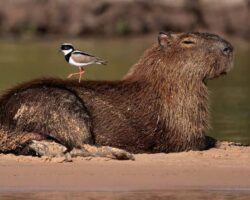It is always a pleasure to read about Capybara facts because they are interesting creatures. Have you wondered where these rodents live and came from?
Without a doubt, the capybara is the largest rodent in the world. They came from South America and can be found in riverine areas, swamps, streams, lakes, and ponds. They also like to live in marshes, forests, grassy terrains, and rivers.
This post shares insights on where capybaras live, where they can be found, and their favorite habitat.
Where Do Capybaras Live?
As mentioned above, Capybara are native to South America, meaning they live across South American countries. Capybaras can be found in places such as Brazil, Peru, Argentina, Columbia, Paraguay, and Venezuela.
Also, capybaras can be found on Central American marshes, grasslands, riverbanks, and ponds; they can be seen in Costa Rica. The reason why capybaras are commonly found in dense vegetation and grasslands is that they need plenty of food.
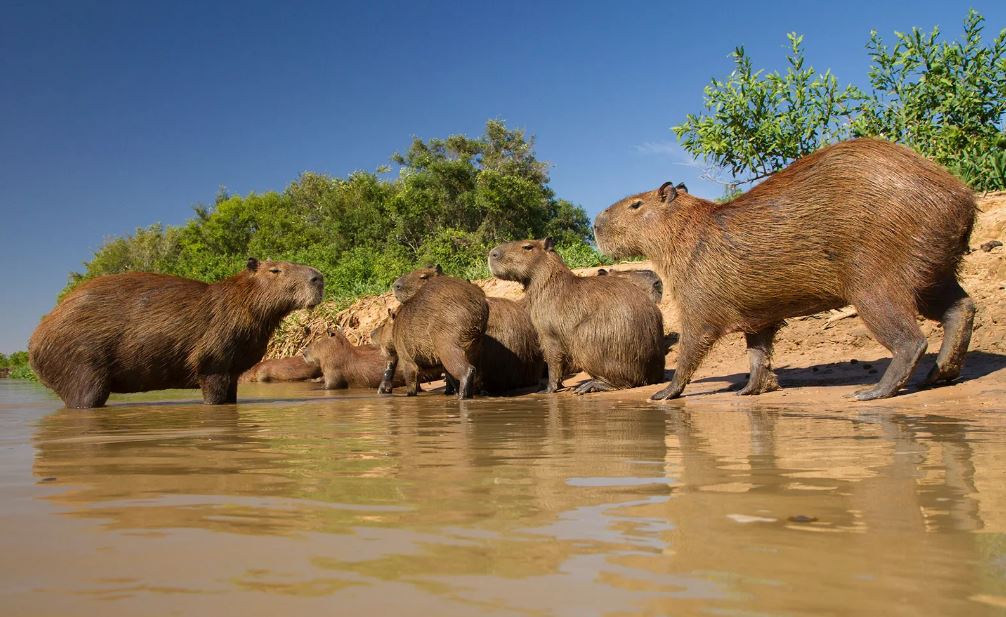
Capybaras have a large appetite and can’t manage starvation, so they need enough food to survive. Moreover, staying close to ponds and water bodies helps them hide from predators. Capybaras are land and semi-aquatic animals, meaning they can live on land and water.
These rodents spend most of their time in water, as they have skin that can dry out quickly. Capybaras typically live in grasslands that share close proximity to water.
They are social animals; and like a family, they live in a group, which can have up to 10, 20, or even 100 capybaras. Capybaras are spotted in the morning and are active at dusk when the temperature is cooler.
Are There Capybaras In South America?
The two known capybara species (the lesser capybara and the known capybara) can be found in South America. The former is called a “lesser capybaras” because it is smaller in size. Aside from the size, it has all the characteristics and habits of a capybara.
While the lesser capybara lives mostly in Panama, the common capybara can be found in almost all South American countries, including Peru, Brazil, Ecuador, Uruguay, Paraguay, Venezuela, Suriname, Bolivia, Columbia, Argentina, and Guyana.
One of the major South American countries where capybaras are rare to find is Chile, as these rodents find it cumbersome to move over the Andes Mountains. However, there is a small number of capybaras in Chile.
Are There Capybaras In Florida?
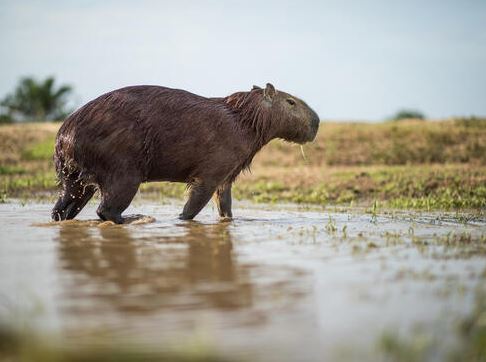
While the capybaras are native to South America, it is interesting to know there are capybaras in other countries. There are several reports of capybaras living in the United States.
There is a pet (it could be a cat, bird, dog, name it) in almost every home in the United States. There are a few accounts of U.S. residents adopting these giant rodents. If you are keen on getting a capybara pet, you may want to verify if it is legal to keep one in your state or locality.
Capybaras have been spotted in Florida. It is legal to keep a capybara in Florida, so it’s common to find these rodents in the farms, lawns, and gardens of their owners.
Are There Capybaras In Japan?
Another fascinating fact is that there are capybaras in Asia. Amazingly, capybaras have been found in Japan. However, these rodents have been in Japan for more than 60 years.
Capybaras can be found in Japanese zoos and animal parks. There is also an animated Japanese cartoon that features a capybara named “Kapibarasan.”
What is The Native Habitat of Capybaras?
Although capybaras are predominantly terrestrial animals, they are also semi-aquatic. These rodents dwell in places with rich vegetation and closeness to water. This is why they are found around regions with swamps, lakes, ponds, marshes, and rivers.
Capybaras thrive in areas with plenty of grasslands, as this will help them graze for food and eat to their full. Also, water is a necessity for them to keep their skin wet and healthy.
It’s common to see capybaras having a yuzu bath or bathing with oranges. This culture helps revitalize their skin and improve their skin health.
Capybara Habitats and Biomes
A capybara’s natural habitat consists of three biomes: rainforests, savannas or grasslands, and wetlands.
1. Rainforests
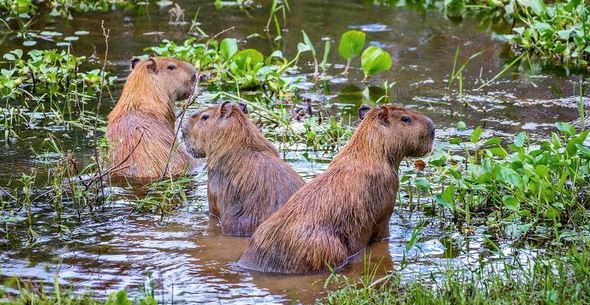
As the name implies, it rains most of the time in tropical rainforests. The abundance of rain also implies that there is a sufficient amount of freshwater available for these rodents to drink.
Rainforests are also rich in vegetation and grasslands, providing capybaras with enough green pastures to feed from and hide from threatening predators.
2. Savannas/Grasslands
Capybaras thrive in grasslands and savannas. However, during the dry season, these animals roam in search of ponds, lakes, and other water sources to keep their skins moist.
The towering grasses in the savanna areas provide covering from predators but the downside is that it makes it difficult for the rodents to detect potential threats. Thankfully, the sharp ears and fast legs of a capybara can help them away from danger.
3. Wetlands
Capybaras can be found in wetlands, as the soil in these terrains is saturated with water to support the growth of water plants. Not to forget, capybaras love aquatic plants, which makes wetlands an ideal environment for them.
The abundant water in this habitat helps these large mammals regulate their temperature and cool the heat on their skins. Wetlands include areas such as fens, swamps, bogs, and marshes.
Why Do Capybaras Live In Groups?
Capybara are very social with themselves and other animals. They find ways to communicate and pass messages to one another, especially in times of need and danger.
Capybaras live in groups of about 10 to 20 individuals; and most times, they could be over 40 or more than 100 capybaras living closely together. Like dogs, capybaras are smart. They are vocal, as they use several sounds and body language to communicate amongst themselves.
It is rare to find a solitary capybara but if you ever get to find one, you must be careful around it, as it could be wild or dangerous.

Know when to play with them and when to allow them to have their space. Most importantly, you should know your limits with any solitary capybara you find in the wild.
Capybaras are hunted worldwide for their meat and skins, so these animals will try to protect themselves with their teeth if threatened or exposed to danger.
Why Do Capybaras Like To Stay In Water?
Capybaras love water and even though they are land animals, it will be impossible to separate a capybaras from the water. These giant rodents can spend almost the whole day swimming, playing, and chilling in the water.
Female capybaras carry their young ones while swimming in water. The four toes of a capybara are partially webbed, allowing them to swim and paddle themselves over the water.
The scientific name of the capybara is Hydrochoerus hydrochaeris and they can also be called water pigs. One of the interesting facts about these rodents is that they can hold their breath underwater for over five minutes and can submerge themselves for over 30 minutes, if necessary. This is surprising considering the fact that there are land animals.
Another surprising fact you do not know about capybaras is that they can sleep underwater. While they sleep in the water, they keep their noses above the water’s surface.
Why Is Water Valuable To Capybaras?
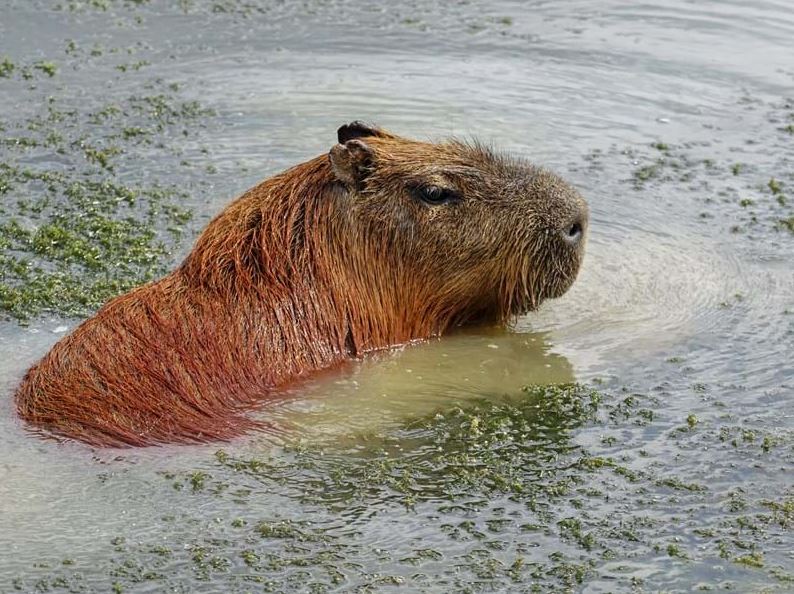
Capybaras are good swimmers who appreciate bodies of water. These rodents are willing to stay around ponds, streams, swamps, rivers, and large bodies of water for many reasons.
Water bodies provide an avenue for capybaras to interact and socialize with themselves. Most especially, water is a natural escape route for them, as it shelters them from potential threats.
The large size of a capybara makes them a juicy, sufficient meal for predators. Capybaras are aware they are endangered and can be targets for predators. Living close to bodies of water helps the capybaras hide themselves from predators.
These rodents can submerge themselves underwater for 5 minutes or even over thirty minutes if necessary. Their vestigial tails and webbed feet help them swim fast away from potential threats and predators.
A capybara’s eyes, ears, and nostrils can be found on its head. So while swimming, they typically keep their heads above the water to breathe while leaving the rest of their bodies underwater. While water can prevent a capybara from being eaten by leopards, jaguars, ocelots, and other land animals, it can make them food for alligators and caimans.
Water is highly beneficial to capybaras and is essential for their survival. The capybara diet consists solely of water grasses, plants, fruits, and vegetables. These large rodents can survive harsh temperatures as long as they find enough water in the area.
As a matter of fact, capybaras prefer warm climates because they feel good when they submerge themselves in water in such conditions. Whenever the temperature gets extreme, a capybara will likely spend the rest of the day in water.
Conclusion
Capybaras came from South and Central America, but can also be found in other countries. These animals live in several natural habitats, mostly around green vegetation, wetlands, flooded forests, savannas, grasslands, marshes, and swamps.
Capybaras are herbivores and their diet consists of aquatic plants, grasses, vegetables, and fruits. They are known to eat fish and insects as well. Capybaras are smart animals; they have a strong sense of smell and sharp ears, which help them detect predators from afar.
Capybaras are important in the food chain and they have a big role to play in the environment. They help reduce the growth of invasive plants around water bodies and provide food for humans and larger animals.
To prevent capybaras from going extinct, it is important to prevent the destruction of their natural habitat. Pertinently, stringent laws should be made to stop humans from poaching these rodents.

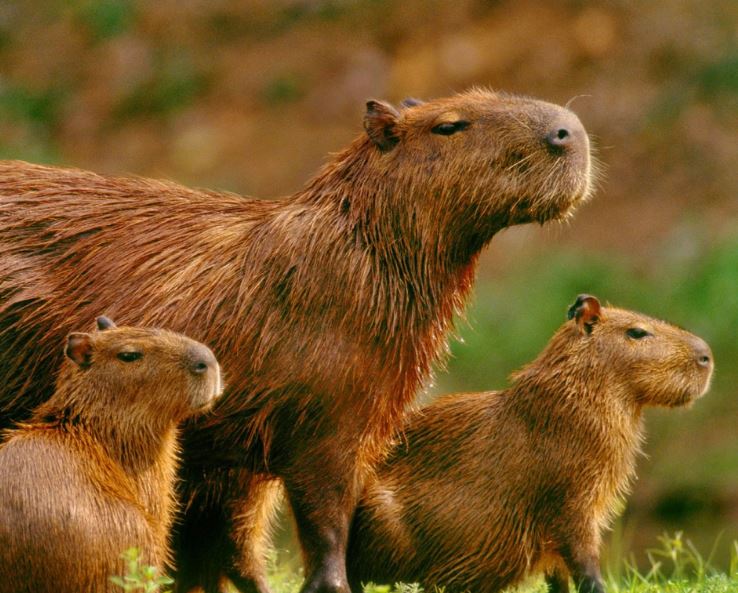

![Capybara Meat And Its Culinary Uses - [Every You Should Know] Capybara Meat & Culinary Uses](https://capybaratips.com/wp-content/uploads/2023/03/Capybara-meat-250x200.webp)
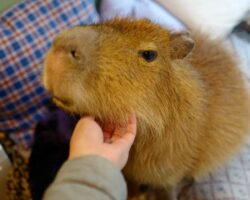

![How Long Do Capybaras Live? - [Answered] How Long Do Capybaras Live](https://capybaratips.com/wp-content/uploads/2023/03/Capybara-Pix-250x200.webp)
